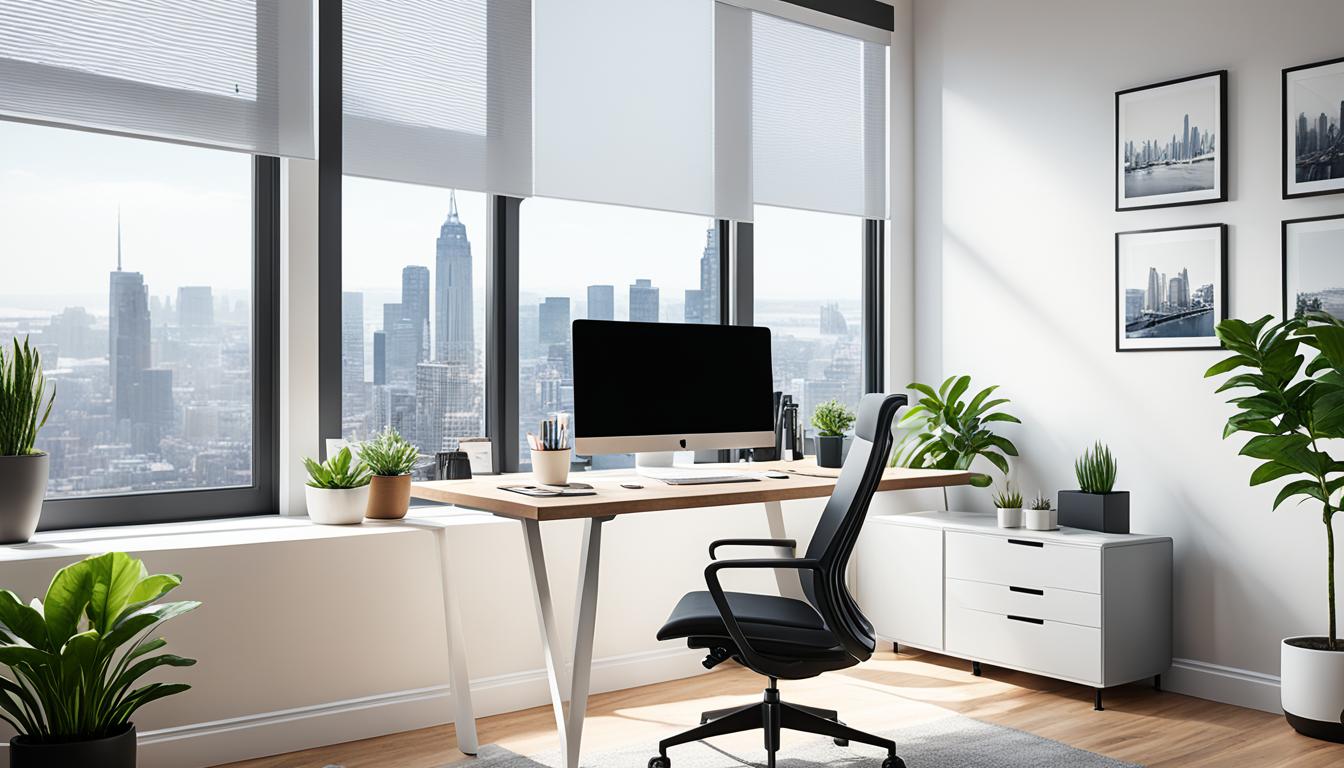In today’s remote work era, optimizing your home office setup is crucial for boosting productivity. With 55% of workers now opting for a hybrid model, having a well-designed workspace at home is more important than ever. A functional home office not only increases efficiency but also supports a better work-life balance. Given the distractions like household chores or family interruptions, effective workspace organization and ergonomic design can greatly improve your focus and performance.
Key Takeaways
- Ergonomic design is vital for comfort during extended work hours.
- 55% of workers favor a hybrid working model.
- 80% of leaders expect remote work to persist post-pandemic.
- A tidy workspace reduces stress and enhances productivity.
- Utilizing circadian lighting can increase focus and calmness.
- Noise-canceling headphones improve communication in virtual meetings.
- Personalizing your workspace can positively affect your mood and motivation.
The Importance of a Functional Home Office Setup
A well-designed office setup is crucial for your productivity and well-being when working remotely. Tailoring your workspace to your needs boosts focus and lowers stress, key for better productivity. Creating an organized space sets the foundation for efficient work habits.
Research indicates that a tidy workspace fosters creativity and mental clarity. Having necessary items within easy reach reduces distractions and helps you stay focused on tasks. Given you might spend about 2,000 hours annually at your desk, it’s vital to make your environment supportive of both focus and comfort.
Using ergonomic furniture is essential in a home office. Non-ergonomic furniture can cause pain and hinder performance over time. Adding a standing desk can help mitigate the health risks of sitting too much. These adjustments not only improve comfort but also enhance your daily work benefits.
Natural light is vital for a welcoming workspace. Sunlight increases energy and sharpens focus, promoting a positive mood. If natural light is scarce, artificial lighting, like desk lamps, can fill the gap, ensuring a well-lit space that benefits both your physical and mental health.
Integrating tools from The Container Store can help organize your workspace and boost productivity. Solutions for cable management and a desk that fits your room’s dimensions create a visually pleasing area. This encourages movement and efficiency in your work.
Choosing the Right Ergonomic Office Furniture
Selecting the right ergonomic office furniture is crucial for boosting productivity and comfort while working from home. A well-designed ergonomic chair should provide lumbar support to prevent back strain, a common problem for those who sit for extended periods. The ability to adjust the chair is key in finding the perfect fit for your body type. A chair that supports a healthy posture can greatly enhance your work experience.
When setting up your home office, consider the desk height. It should be adjustable to ensure your elbows rest comfortably while typing. A monitor placed 20 to 40 inches away from your eyes, with the top at or slightly below eye level, is ideal. This setup reduces neck strain and improves focus, creating a more comfortable work environment.
Using ergonomic office furniture can significantly improve health and productivity. Studies show that desks and chairs designed for comfort lead to better wellbeing. Embracing this approach can make work more enjoyable and reduce physical strain.
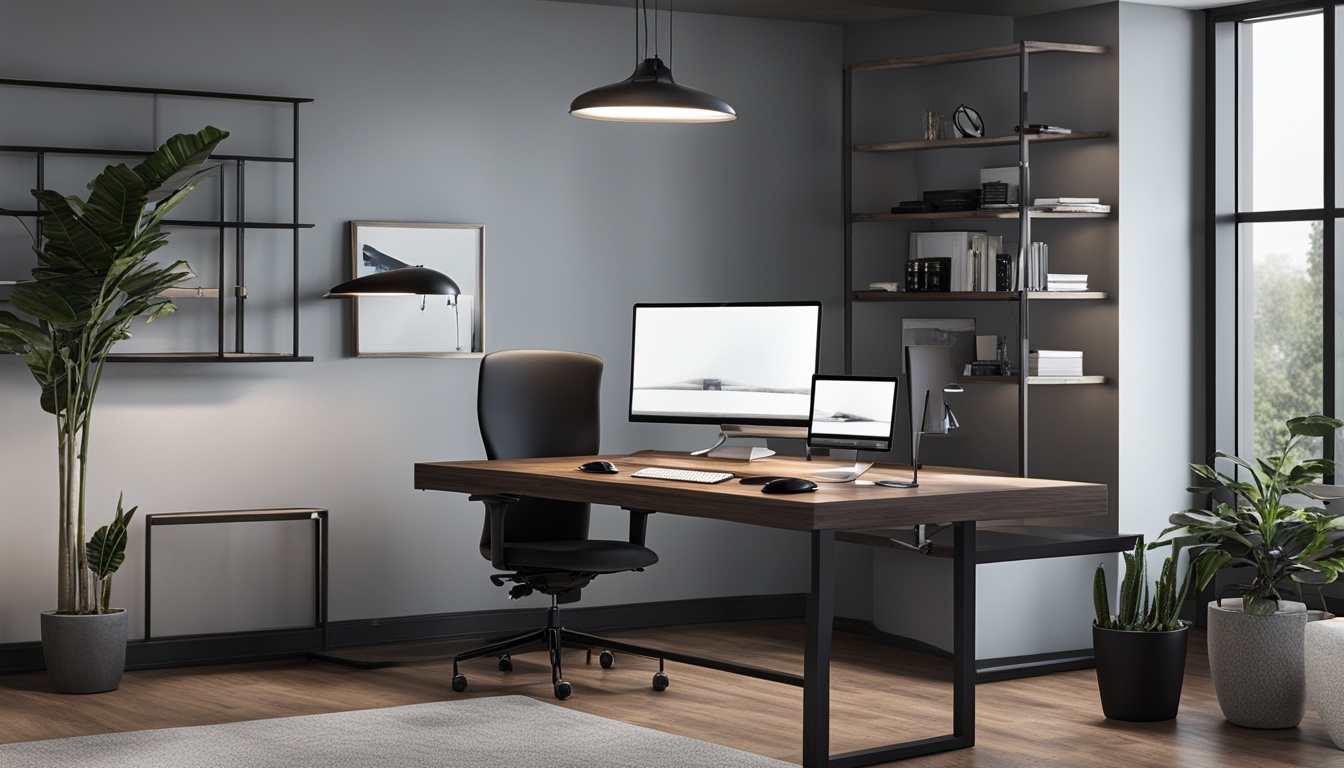
Workspace Organization Tips for Efficiency
Effective workspace organization is key to boosting your productivity. Start by decluttering, keeping only the daily essentials on your desk. A tidy workspace aids mental clarity; a cluttered one can lead to a cluttered mind, affecting focus.
Use storage solutions like filing cabinets and drawer organizers to keep work and personal items separate. An organized workspace aids in a smoother workflow and cuts down the stress of losing items. It also fosters a sense of calm, boosting your confidence in tackling tasks.
Regular decluttering and cleaning routines can significantly improve your productivity. A systematic approach to workspace organization keeps your setup efficient, allowing you to focus better. Make the most of vertical space, especially if your desk is cramped. Effective storage and cable management make your workspace neater and more motivating.
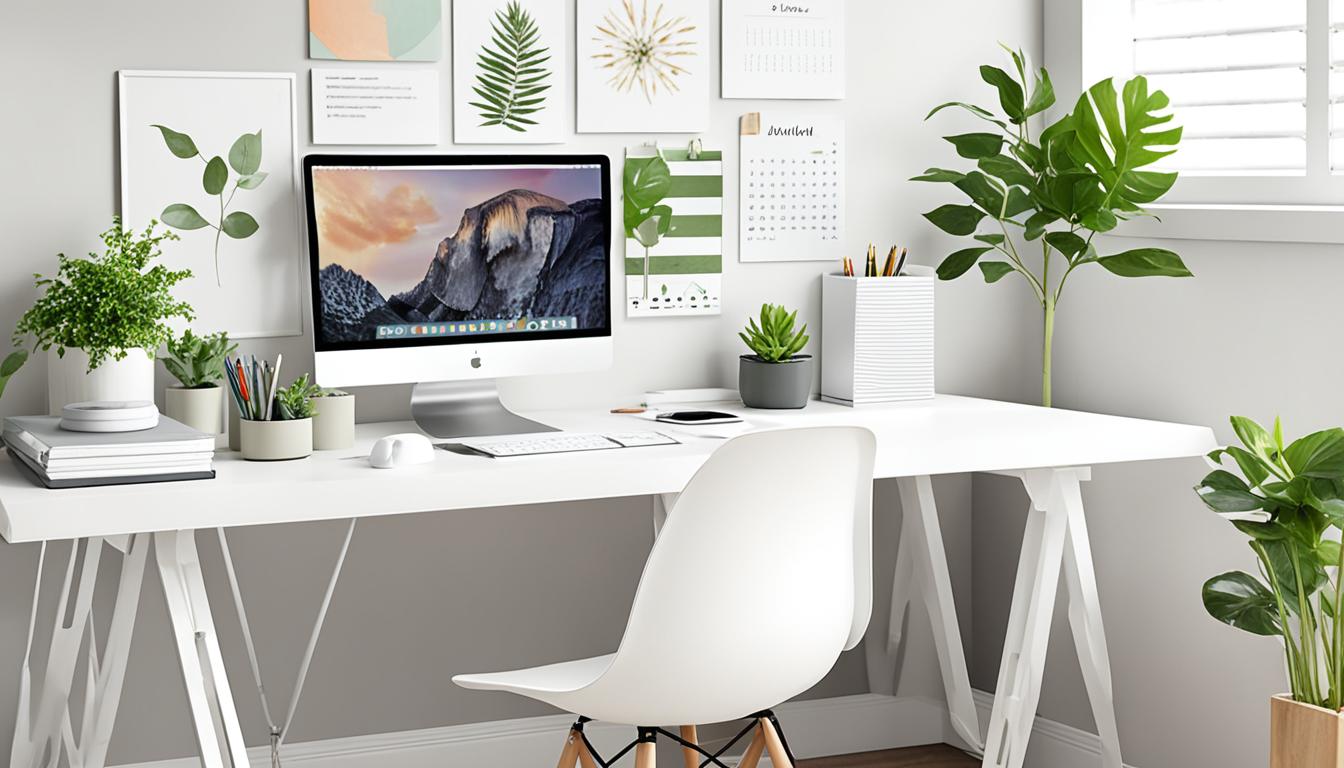
Investing in comfortable furniture is vital for an organized home office. Comfortable seating reduces eye strain and body aches, enabling you to work longer without discomfort. Tailor your workspace to your job’s needs, which can greatly boost your productivity. Follow these productivity tips to create an environment that supports your daily tasks.
Lighting Techniques to Boost Productivity
Effective productivity lighting is crucial in any home office setup. Many spaces lack sufficient natural light, making artificial lighting essential. Positioning your desk near a window allows for natural light, enhancing your work environment. When sunlight isn’t enough, consider circadian lighting, which adjusts brightness to match your body’s rhythms. This keeps you energized and focused.
Ambient lighting often doesn’t provide enough functional illumination. Using task lighting, like desk lamps, ensures specific areas get the right amount of light without straining your eyes. Thoughtful placement of these lights reduces glare on screens. Lampshades can soften harsh light, making your workspace more inviting.
For an optimal setup, consider your workstation’s orientation. Facing your desk towards the north or south prevents shadows and glare. Solar shades offer a stylish way to soften light while keeping views intact. Decorative and accent lighting not only beautify your space but also boost your mood and productivity.
Adjusting light color temperatures can affect your performance. Warmer tones create a cozy atmosphere, while bright white light promotes alertness. LED bulbs are eco-friendly and cost-efficient, ensuring your lighting is sustainable. Dimmers allow you to control light intensity, improving eye comfort and energy efficiency.
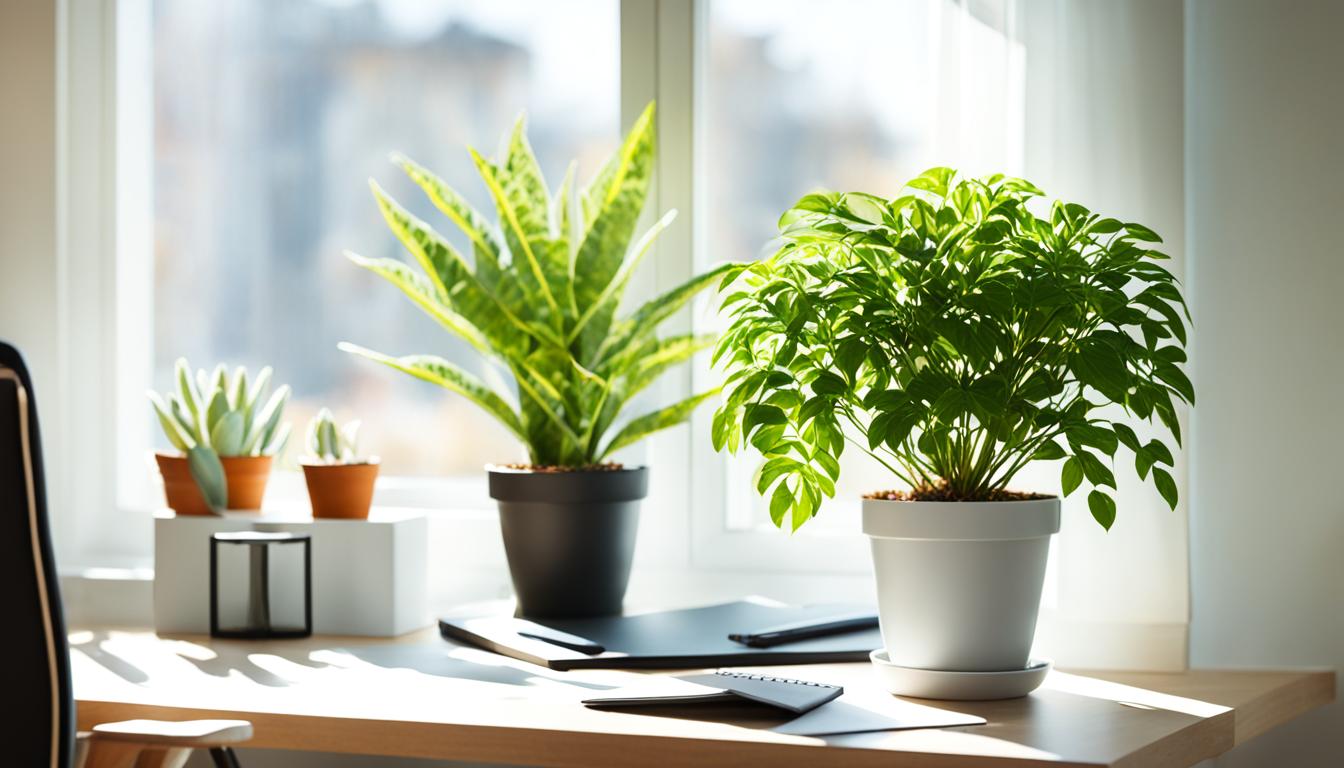
Maximizing Space: Effective Desk and Chair Arrangement
Creating an effective desk arrangement is crucial for maximizing your workspace and ensuring an efficient office layout. Positioning your desk correctly can improve your workflow and minimize distractions. Ensure your computer screen is at eye level for an ergonomic setup, which promotes good posture and comfort during work hours.
When selecting a chair, prioritize support for long hours of sitting. Look for features like height adjustability, lumbar support, and a 360-degree swivel base. An ergonomic height-adjustable desk also allows you to switch between sitting and standing, which can alleviate discomfort from prolonged sitting.

To optimize your space further, keep essential items within arm’s reach. Storing frequently used supplies nearby reduces unnecessary movements and keeps your focus sharp. Use dedicated storage options like cubby systems or vertical storage to maintain a tidy workspace, fostering a more productive environment.
If your home office doesn’t have a dedicated room, consider using privacy dividers like floor screens or hanging curtains. These can help define work areas and maintain concentration. When designing your workspace, consider a partner desk setup if you share the space. This ensures everyone has enough room to work comfortably.
Home Office Setup: Enhancing Your Work Environment
Setting up an effective home office is more than just placing a desk and chair. It’s about crafting a space that mirrors your personality. Ensuring your workspace is comfortable is crucial for productivity. Incorporate elements that boost comfort, creativity, and motivation.
Creating a Comfortable Workspace
A comfortable workspace greatly affects your well-being and performance. Invest in ergonomic furniture, such as a chair with lumbar support, to maintain good posture. Consider a height-adjustable desk to switch between sitting and standing, which can improve health and productivity.
Upgrade your technology too; a large monitor can make focused tasks more comfortable, and an ergonomic keyboard can prevent strain. With nearly 64% of employees feeling more productive remotely, your home office setup should support this increase in productivity.
Incorporating Personal Touches
Adding personal touches can make your workspace feel uniquely yours. Use office decor ideas that reflect your identity, such as artwork, family photos, or motivational quotes. Plants are also beneficial; they can reduce stress and create a healthier work environment.
Consider adding personal elements that bring joy and inspiration. Tailoring your space to your preferences creates an inviting environment. This can lead to greater job satisfaction and overall happiness while working remotely.
Utilizing Technology: The Best Tools for Remote Work
For a well-functioning home office, the right technology is crucial. Essential tools include video conferencing software like Zoom and Dialpad, which ensure clear communication and foster team collaboration. Over 91% of remote workers depend on such software to stay in touch. These platforms facilitate discussions and support teamwork through shared resources and screen-sharing.
Project management tools, such as Trello and Hive, are also indispensable for productivity. They help in organizing tasks and tracking project progress, ensuring team accountability. Reports show that 62% of remote workers use these tools, underscoring their role in maintaining efficient workflows. Platforms like Google Drive and Dropbox enable easy file sharing and real-time collaboration, enhancing team productivity.
Technology integration is key to successful remote work. Unified communications tools, like Slack, streamline team interactions, ensuring no communication gaps. By adopting such applications, teams gain flexibility and accessibility, crucial for remote work success.
Investing in cloud computing services also offers substantial benefits, including cost savings and scalability. Early adoption is critical; companies that delay cloud integration risk falling behind by 2024. Tools like TeamViewer allow remote access to office computers, further boosting work capabilities.
In summary, choosing the right technology can significantly improve your remote work experience, making collaboration smoother and boosting productivity. For more on organizing your workspace, check out essential home office organization tips.
Implementing Productivity Techniques in Your Workflow
Integrating productivity techniques into your daily routine can dramatically boost your focus and output. The Pomodoro Technique is a prime example, where you work for 25 minutes, followed by a 5-minute break. This method not only keeps your concentration sharp but also reduces the chance of burnout, making your work more effective.
The Pomodoro Technique
This technique promotes a structured work pattern, ensuring you approach tasks with a clear mind after each break. By managing time more effectively, you enhance productivity and stay focused on your goals. Consider using a timer to mark work and break times, which helps stick to this method. Combining this with a well-organized task management system can significantly boost your outcomes.
Task Management Systems
Systems like Notion or Trello consolidate all your tasks and deadlines into one spot. This organization provides a clear view of your responsibilities, simplifying task prioritization. By focusing on tasks that produce the most significant results, you apply the Pareto Principle effectively. Integrating these systems with techniques like the Pomodoro Technique ensures every moment is utilized efficiently in your day.
Reducing Distractions in Your Home Office
Creating a dedicated workspace is crucial for reducing distractions and maintaining focus at home. Optimizing your work environment boosts productivity and supports goal achievement. Practical strategies help you stay focused and minimize interruptions.
Strategies to Stay Focused
Start by choosing a quiet spot in your home for your office. This choice significantly reduces distractions and creates a peaceful setting. Set clear boundaries with family about your work hours. A simple “do not disturb” signal effectively communicates your need for focus.
Decluttering your desk is key to a well-organized workspace. A minimalist setup reduces visual distractions and fosters calm and clarity. Investing in quality ergonomic furniture improves comfort and productivity, helping you stay engaged with tasks.
Having efficient technology, like high-speed internet and reliable hardware, supports your work environment. Managing digital distractions by turning off non-essential app notifications helps focus your attention on important tasks.
Time management techniques are vital for maintaining focus. A structured schedule and productivity methods keep you on track despite potential disruptions. Regular breaks, such as short walks or mindfulness exercises, refresh your mind and keep your energy levels up.
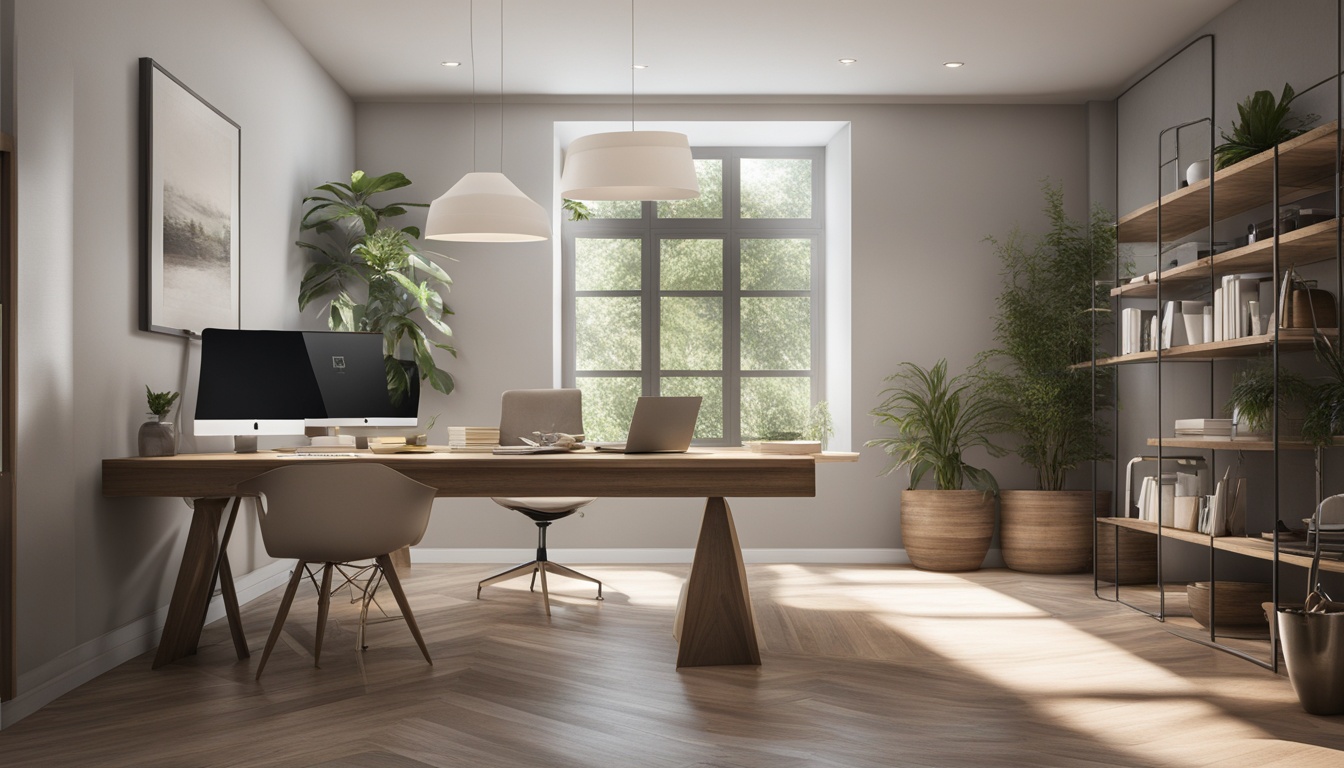
Personalizing your workspace with inspiring decor makes it more enjoyable and motivating. Periodically evaluate your setup to ensure it still meets your needs and supports work. These strategies can turn your home office into a productive sanctuary, crucial for remote work success.
Incorporating Greenery for a Healthier Environment
Introducing indoor plants to your home office can greatly improve air quality. A healthier workspace benefits both your physical and mental health. Studies show that adding greenery can boost productivity by up to 15%. Plants like snake plants and pothos are not only visually appealing but also easy to maintain. They adapt to various lighting conditions, making them perfect for any office setup.
Indoor plants enhance air quality, reducing stress and boosting creativity. Research suggests that being around nature improves cognitive function and sleep quality, crucial for those working long hours. Adding plants turns a mundane workspace into a place that sparks creativity and promotes focused work.
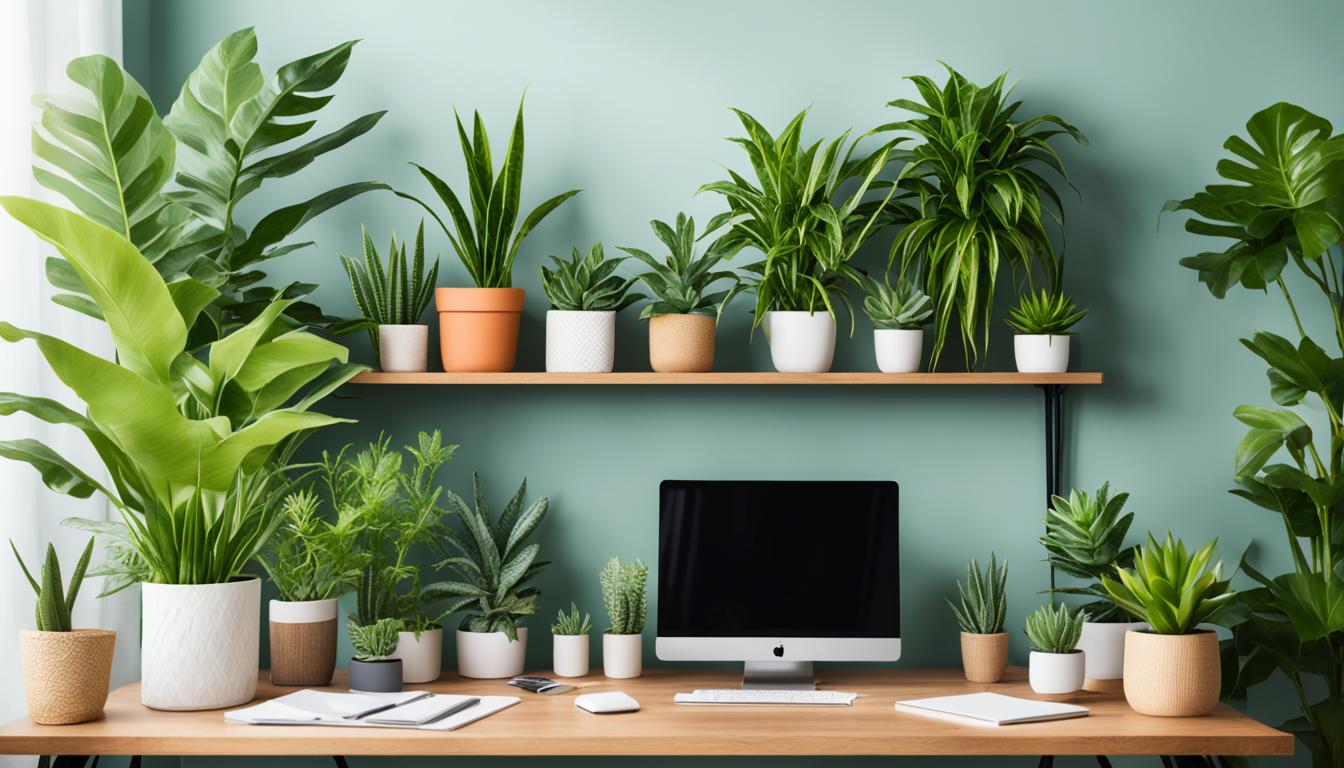
Choosing sustainable furniture options also contributes to a healthier work environment. Opting for furniture made from sustainably harvested wood or bamboo supports eco-friendly living. Incorporating natural elements, such as reclaimed wood and natural light, creates a biophilic office design. This design can significantly improve employee morale and productivity.
Indoor plants not only make your space look better but also filter out toxins, making the workspace healthier. This leads to better focus and alertness, vital for efficiently handling daily tasks.
Conclusion
In today’s era, the rise of remote work demands a well-designed home office setup for better productivity and satisfaction. Investing in ergonomic furniture and organized solutions enhances efficiency and long-term health. The setup of your office significantly influences task flow and focus throughout the day.
Lighting is crucial for productivity. Natural light boosts mood and creates a positive work atmosphere. Adding greenery to your space can increase motivation and make work more enjoyable.
Technology, like a robust internet connection and reliable tools, keeps you connected and effective at home. With routines and minimized distractions, a thoughtful home office setup improves productivity and work-life balance.
FAQ
How can I create an effective home office setup?
What are some productivity tips for my home office?
Why is ergonomic design important for my home office?
How can I improve workspace organization?
What lighting options can help boost my productivity?
Any advice for desk arrangement to maximize space?
How can I make my workspace more comfortable and inviting?
What technology should I integrate for remote work?
How do I effectively reduce distractions while working from home?
What type of indoor plants are best for my home office?
Source Links
- 5 Ways To Improve Your Home Office For Productivity And Happiness – https://www.forbes.com/sites/ashleystahl/2021/04/07/5-ways-to-improve-your-home-office-for-productivity-and-happiness/
- 8 Best Home Office Setup Ideas for 2024 (+ Productivity Tips) – https://fitsmallbusiness.com/home-office-setup/
- 10 Ways To Create A Functional Home Office | Spacejoy – https://www.spacejoy.com/interior-designs-blog/functional-home-office-ideas-for-organization
- Home Office Setup Guide 2024: The Fundamentals – https://medium.com/calibra-setups/home-office-setup-guide-2024-the-fundamentals-3ab14a56364e
- Designing a Functional and Comfortable Remote Office Space | Boost Your Productivity at Home – https://www.reworc.com/designing-a-functional-and-comfortable-remote-office-space/
- Office ergonomics: Your how-to guide – https://www.mayoclinic.org/healthy-lifestyle/adult-health/in-depth/office-ergonomics/art-20046169
- Ergonomic Home Office Setup: Comprehensive Guide – https://www.scube-ergo.com/blog/guide-on-ergonomic-home-office-setup
- How to Choose the Right Ergonomic Office Chair for Your Needs – BodyBilt – https://bodybilt.com/how-to-choose-the-right-ergonomic-office-chair-for-your-needs/
- Home Office Organization: Tips for a Productive Workspace – https://everhour.com/blog/home-office-organization/
- How To Organize Your Office At Home: Tips and Tricks – https://supliful.com/blog/how-to-organize-your-office-at-home
- Five Tips for Better Home Office Lighting – https://www.thespruce.com/tips-for-better-home-office-lighting-1812436
- 13 Home Office Lighting Tips You Need to Know – https://store.haworth.com/blogs/articles/13-home-office-lighting-tips-you-need-to-know
- How to Set Up a Home Office You Love: 12 Tips – https://www.flexjobs.com/blog/post/setting-up-home-office-v2/
- 9 Essential Home Office Design Tips – https://www.roomsketcher.com/blog/home-office-design/
- Home Office Setup Ideas That Will Up Your WFH Game – PODS Blog – https://www.pods.com/blog/home-office-setup
- 7 Ways to Spice Up Your Work-From-Home Environment – https://www.ecisolutions.com/blog/7-ways-to-spice-up-your-work-from-home-environment/
- How to Create the Perfect Home Office Setup for Remote Work – https://www.rovetravel.com/blog/create-perfect-home-office-setup-for-remote-work
- The best technology for remote working: 4 essential tools – https://resources.owllabs.com/blog/remote-working-technology
- 28 Remote Work Tools & Software To Work From Home 2024 – https://hive.com/blog/remote-work-tools/
- 7 Ultimate Desk setup hacks for work productivity – Minimal Desk Setups – https://www.minimaldesksetups.com/7-desk-setup-hacks-for-work-productivity/
- 10 Tips for Creating a Productive Home Office Setup – https://zight.com/blog/productive-home-office-setup/
- Home Office Setup Ideas: The Ultimate Guide to Setting Up a Productive Workspace at Home – ViewSonic Library – https://www.viewsonic.com/library/business/home-office-setup-ideas-the-ultimate-guide-to-setting-up-a-productive-workspace-at-home/
- How to Set Up a Distraction-Free Home Office for Maximum Productivity – https://www.linkedin.com/pulse/how-set-up-distraction-free-home-office-maximum-robert-baines
- How I Designed My New Office for Focus and Less Distraction – The Sweet Setup – https://thesweetsetup.com/how-i-designed-my-new-office-for-focus-and-less-distraction/
- Create a Green Home Office in 2024: The Ultimate Guide – https://be.green/en/blog/create-a-green-home-office-in-2024-the-ultimate-guide?srsltid=AfmBOooTK77Se7mPVG4MsRd1AM2ThoodK0AghLfUmipzwbwy3m4tE7-d
- Tips to Create Green Living Spaces in Homes and Offices – https://www.planetcustodian.com/green-living-spaces-tips-benefits/31431/
- Green Your Office » Sustainability » University of Florida Business Affairs » University of Florida – https://sustainable.ufl.edu/2021/09/29/action-of-the-month-green-your-office/
- 10 Tips in Building a Productive Home Office Setup for Remote Work – https://www.linkedin.com/pulse/10-tips-building-productive-home-office-setup-remote-work-magatao
- Setting Up Home Office for Maximum Productivity – https://www.nearity.co/blog/design-home-office-setup

